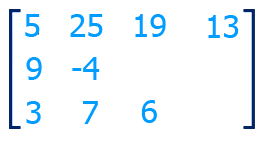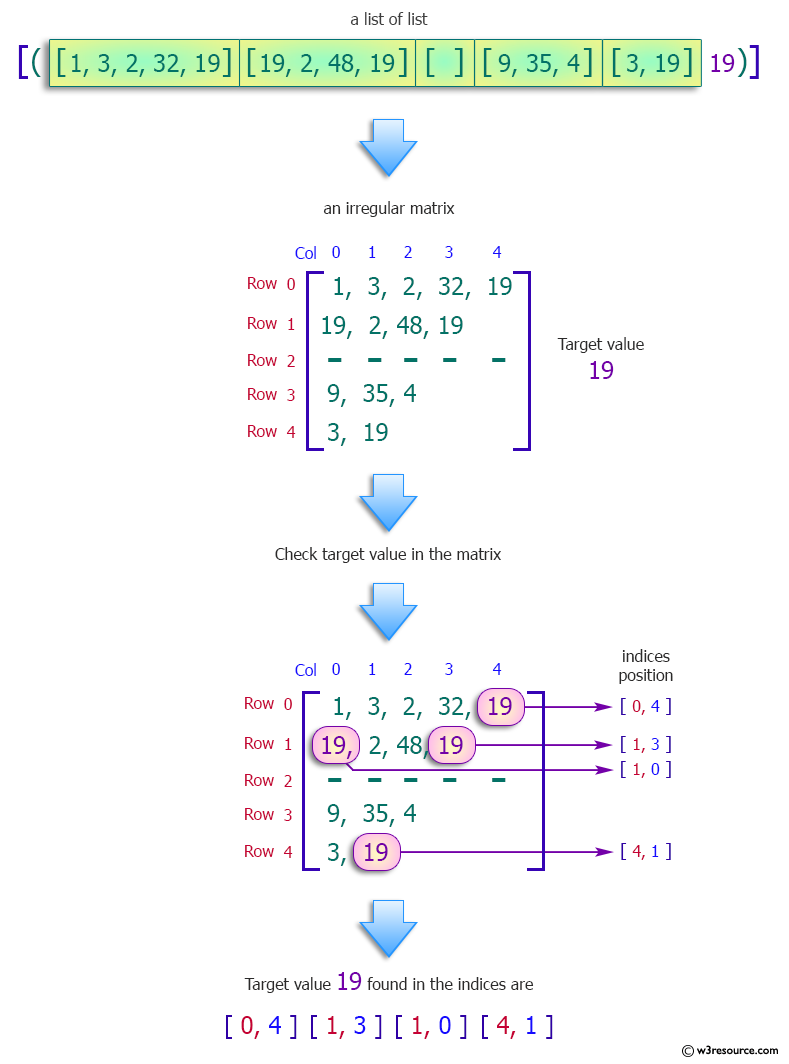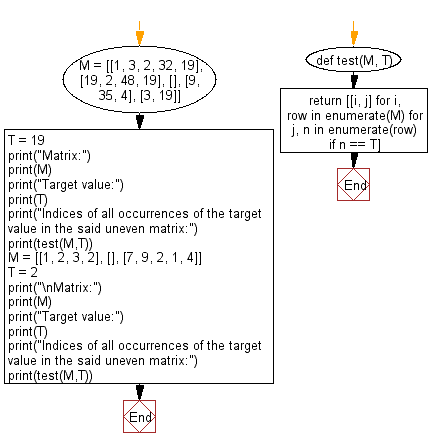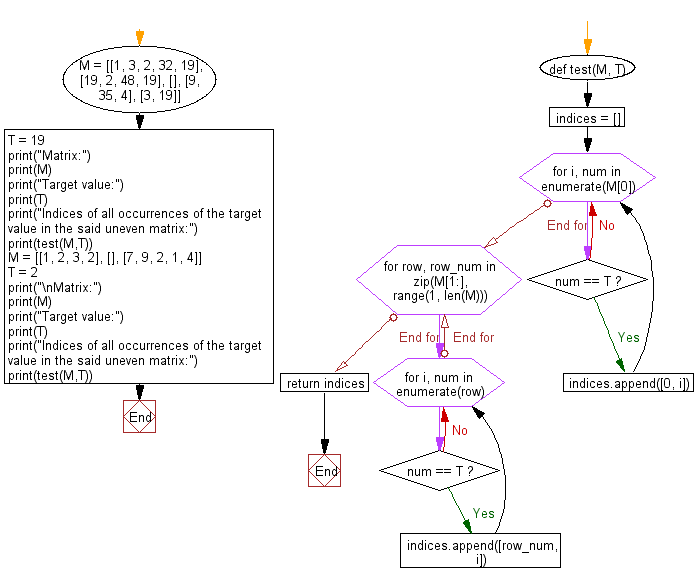Python: Find the indices of all occurrences of target in the uneven matrix
Python Programming Puzzles: Exercise-18 with Solution
An irregular/uneven matrix, or ragged matrix, is a matrix that has a different number of elements in each row. Ragged matrices are not used in linear algebra, since standard matrix transformations cannot be performed on them, but they are useful as arrays in computing.
Write a Python program to find the indices of all occurrences of target in the uneven matrix.

Input: [([1, 3, 2, 32, 19], [19, 2, 48, 19], [], [9, 35, 4], [3, 19]), 19] Output: [[0, 4], [1, 0], [1, 3], [4, 1]] Input: [([1, 2, 3, 2], [], [7, 9, 2, 1, 4]),2] Output: [[0, 1], [0, 3], [2, 2]]
Pictorial Presentation:

Sample Solution-1:
Python Code:
def test(M, T):
return [[i, j] for i, row in enumerate(M) for j, n in enumerate(row) if n == T]
M = [[1, 3, 2, 32, 19], [19, 2, 48, 19], [], [9, 35, 4], [3, 19]]
T = 19
print("Matrix:")
print(M)
print("Target value:")
print(T)
print("Indices of all occurrences of the target value in the said uneven matrix:")
print(test(M,T))
M = [[1, 2, 3, 2], [], [7, 9, 2, 1, 4]]
T = 2
print("\nMatrix:")
print(M)
print("Target value:")
print(T)
print("Indices of all occurrences of the target value in the said uneven matrix:")
print(test(M,T))
Sample Output:
Matrix: [[1, 3, 2, 32, 19], [19, 2, 48, 19], [], [9, 35, 4], [3, 19]] Target value: 19 Indices of all occurrences of the target value in the said uneven matrix: [[0, 4], [1, 0], [1, 3], [4, 1]] Matrix: [[1, 2, 3, 2], [], [7, 9, 2, 1, 4]] Target value: 2 Indices of all occurrences of the target value in the said uneven matrix: [[0, 1], [0, 3], [2, 2]]
Flowchart:

Visualize Python code execution:
The following tool visualize what the computer is doing step-by-step as it executes the said program:
Sample Solution-2:
Python Code:
#License: https://bit.ly/3oLErEI
def test(M, T):
indices = []
for i, num in enumerate(M[0]):
if num == T:
indices.append([0, i])
# Search for element starting from the first column and storing the indices of the found elements in a list
for row, row_num in zip(M[1:], range(1, len(M))):
for i, num in enumerate(row):
if num == T:
indices.append([row_num, i])
return indices
M = [[1, 3, 2, 32, 19], [19, 2, 48, 19], [], [9, 35, 4], [3, 19]]
T = 19
print("Matrix:")
print(M)
print("Target value:")
print(T)
print("Indices of all occurrences of the target value in the said uneven matrix:")
print(test(M,T))
M = [[1, 2, 3, 2], [], [7, 9, 2, 1, 4]]
T = 2
print("\nMatrix:")
print(M)
print("Target value:")
print(T)
print("Indices of all occurrences of the target value in the said uneven matrix:")
print(test(M,T))
Sample Output:
Matrix: [[1, 3, 2, 32, 19], [19, 2, 48, 19], [], [9, 35, 4], [3, 19]] Target value: 19 Indices of all occurrences of the target value in the said uneven matrix: [[0, 4], [1, 0], [1, 3], [4, 1]] Matrix: [[1, 2, 3, 2], [], [7, 9, 2, 1, 4]] Target value: 2 Indices of all occurrences of the target value in the said uneven matrix: [[0, 1], [0, 3], [2, 2]]
Flowchart:

Visualize Python code execution:
The following tool visualize what the computer is doing step-by-step as it executes the said program:
Python Code Editor :
Have another way to solve this solution? Contribute your code (and comments) through Disqus.
Previous: Find a string consisting of the non-negative integers up to n inclusive.
Next: Split a string into strings if there is a space in the string, otherwise split on commas, otherwise the list of lowercase letters with odd order.
What is the difficulty level of this exercise?
Test your Programming skills with w3resource's quiz.
Python: Tips of the Day
Find current directory and file's directory:
To get the full path to the directory a Python file is contained in, write this in that file:
import os dir_path = os.path.dirname(os.path.realpath(__file__))
(Note that the incantation above won't work if you've already used os.chdir() to change your current working directory, since the value of the __file__ constant is relative to the current working directory and is not changed by an os.chdir() call.)
To get the current working directory use
import os cwd = os.getcwd()
Documentation references for the modules, constants and functions used above:
- The os and os.path modules.
- The __file__ constant
- os.path.realpath(path) (returns "the canonical path of the specified filename, eliminating any symbolic links encountered in the path")
- os.path.dirname(path) (returns "the directory name of pathname path")
- os.getcwd() (returns "a string representing the current working directory")
- os.chdir(path) ("change the current working directory to path")
Ref: https://bit.ly/3fy0R6m
- New Content published on w3resource:
- HTML-CSS Practical: Exercises, Practice, Solution
- Java Regular Expression: Exercises, Practice, Solution
- Scala Programming Exercises, Practice, Solution
- Python Itertools exercises
- Python Numpy exercises
- Python GeoPy Package exercises
- Python Pandas exercises
- Python nltk exercises
- Python BeautifulSoup exercises
- Form Template
- Composer - PHP Package Manager
- PHPUnit - PHP Testing
- Laravel - PHP Framework
- Angular - JavaScript Framework
- Vue - JavaScript Framework
- Jest - JavaScript Testing Framework
